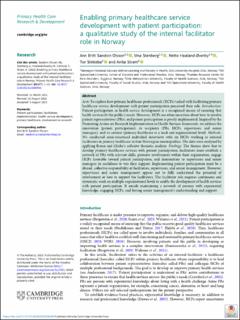Enabling primary healthcare service development with patient participation: a qualitative study of the internal facilitator role in Norway
Peer reviewed, Journal article
Published version

View/
Date
2023Metadata
Show full item recordCollections
Original version
Primary Health Care Research and Development. 2023, 24 1-11. 10.1017/S1463423623000488Abstract
Aim: To explore how primary healthcare professionals (HCPs) tasked with facilitating primary
healthcare service development with patient participation perceived their role. Introduction:
Patient participation in health service development is a recognized means of ensuring that
health services fit the public’s needs. However, HCPs are often uncertain about how to involve
patient representatives (PRs), and patient participation is poorly implemented. Inspired by the
Promoting Action on Research Implementation in Health Services framework, we address the
innovation (patient participation), its recipients (PRs, HCPs, supervisors, and senior
managers), and its context (primary healthcare at a local and organizational level). Methods:
We conducted semi-structured individual interviews with six HCPs working as internal
facilitators in primary healthcare in four Norwegian municipalities. The data were analyzed by
applying Braun and Clarke’s reflexive thematic analysis. Findings: The themes show that to
develop primary healthcare services with patient participation, facilitators must establish a
network of PRs with relevant skills, promote involvement within their organization, engage
HCPs favorable toward patient participation, and demonstrate to supervisors and senior
managers its usefulness to win their support. Implementing patient participation must be a
shared, collective responsibility of facilitators, supervisors, and senior management. However,
supervisors and senior management appear not to fully understand the potential of
involvement or how to support the facilitators. The facilitator role requires continuous and
systematic work on multiple organizational levels to enable the development of health services
with patient participation. It entails maintaining a network of persons with experiential
knowledge, engaging HCPs, and having senior management’s understanding and support.
